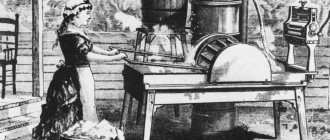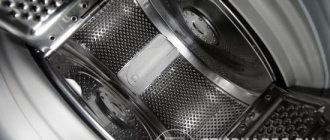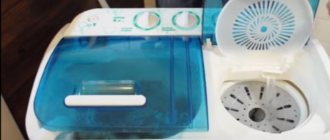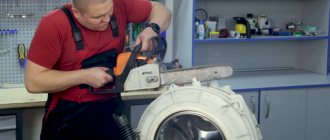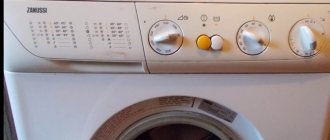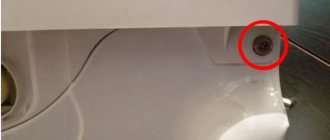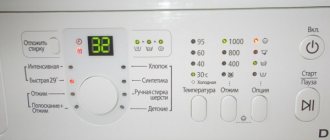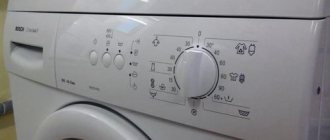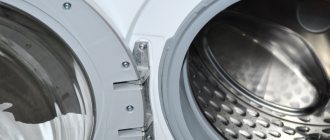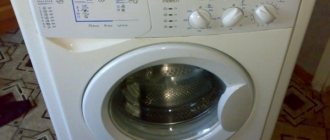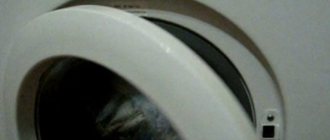Types of washing machines
First of all, you need to decide what kind of washing machine you want. There are four main types, and your choice will mainly depend on the size of the room you have available. Below are the different models:
Freestanding washing machines
This is the most popular type. The freestanding machine does not fit into cabinets, but is flexible enough to be used in a variety of locations. Standard sizes allow it to fit under most kitchen countertops.
Built-in washing machines
These machines are designed to be installed in a kitchen unit and are hidden behind a door that matches other cabinets. Built-in options can be more expensive and slightly smaller than freestanding machines, but they are usually quieter since the cabinet door can muffle noise.
Semi-built washing machines
They may also cost more than free-standing models. The control panel is visible, but the drum is hidden behind the door. You will need a door panel from your kitchen fittings supplier to match your kitchen fittings.
Washer dryers
Buying a washer and dryer can be expensive and take up a lot of space. This is where washer dryers come in handy. These two-in-one models can be a great solution if you're looking for one machine to do everything. The washing part works like any standard washing machine, and the drying part works like a heat pump dryer. In our testing, we found that washer-dryers generally don't perform as well as separate washers and dryers. Moreover, washer-dryers may have drying performance that does not match washing performance. This means that while you can wash 10kg, you can only dry 4kg in the same machine.
Design selection criteria
Selecting a washing machine according to its parameters is not difficult if you understand the main points. What model of automatic machine are you looking for? Decide on the following:
- Type of machine (standard, compact or washer-dryer). Choose based on your needs and purposes of use. If you have limited space to install the SMA, then it is better to buy a compact model. An automatic machine with a drying function copes with two tasks at once: washing and drying clothes. It costs more than usual, which is quite logical.
- Loading type (front or vertical). For a front-facing machine, the loading hatch is located on the front panel; for a vertical machine, it is located on the top cover of the device. The second loading option is more convenient than the first, since you do not need to bend over to put or remove laundry from the drum. Machines with a vertical loading type are more compact, so they are suitable for installation in any room. Another plus is the ability to interrupt the cycle at any time and load additional items into the drum.
- Installation type (built- in or solo model). Built-in automatic machines can be fully built-in (completely hidden behind furniture) or with the possibility of being built-in. The second option has a removable top panel for placing the device under the countertop. Since fully built-in washing machines are rigidly attached to the walls of the unit, they are less noisy in operation. Otherwise, built-in automatic machines do not differ in any fundamental way from free-standing ones.
- Dimensions of the machine and drum capacity. When purchasing an automatic machine, you should take into account the dimensions of the intended installation site and the capacity of the drum. Most vertical machines have the following dimensions: height - 85-90 cm, depth - 60 cm, width - 40 cm, with a maximum load of 5-6 kg of dry laundry. Front washing machines have many variations - both in terms of size and drum volume. See their standard sizes in the photo below.
- Opening the door. Choose a model where the opening angle of the hatch door will be 180 degrees. This will save you from discomfort while loading and unloading clothes from the drum.
- Tank material. The tank can be made of stainless steel or composite materials. In the first case, the equipment will last you longer, but will be quite noisy in operation. But composite material, although of lower quality, can absorb vibrations. Therefore, washing machines in which the tank is made of carbonara or polyplex will not be so noisy.
To choose the right washing machine according to its parameters, the above information will not be enough. What other characteristics need to be taken into account? We will talk about this further.
Characteristics of a good washing machine
Drum dimensions
Washing machines are more efficient and energy efficient when they're full, so it's worth thinking about how much laundry you'll be washing at one time. The drum capacity varies from 3 kg to 12 kg, with the weight referring to the dry laundry that can fit in the drum. Many machines hold between 8 and 10 kg.
This is a great size for large families or those who like to wash everything at once. How much laundry you can fit also depends on the program you choose.
Spin speed
The faster the spin, the more water is removed, so clothes don't have to sit in the dryer or on the clothesline for long. It's worth paying attention to the speed, but any machine that spins between 400 and 1,400 rpm will do the job well. Some high-end models can spin up to 1,800 rpm on the cotton program, but higher spin speeds can cost more and are usually noisier.
Energy efficiency
To find out how economical and efficient your new washing machine will be, look at its energy rating. Every new car has one, and newer models tend to be more efficient than older ones.
Currently the rating scale goes from A to G - A being the most energy efficient - but previously it included A+++, A++ and A+. These have been removed to simplify the scale and reflect increasingly cost-effective technologies. Now most cars that were A+++ will be rated B or C, leaving room for new developments and improvements.
Specifications
The choice of an automatic machine should be based on other equally important criteria, such as energy consumption classes, type of control, selection of programs and additional functions. Let's look at them in more detail.
Energy consumption and energy efficiency classes
Depending on how much water and electricity a washing machine consumes, it is assigned an appropriate class. They are designated by letters of the Latin alphabet (from A to G). The most economical models are class A and B, respectively G is the most costly in terms of energy consumption. There are also classes A+, A++ and even A+++, which indicate the most economical consumption of energy resources by the device without losing its main functionality.
Washing class
Washing efficiency is also indicated in Latin letters. The better the equipment copes with dirt and stains, the higher the class it is assigned. Marking of equipment also takes into account such points as:
- how effectively the clothes are moistened by the detergent solution;
- how carefully care is taken for items made from delicate fabrics.
Spin class
Spin is characterized by the drum rotation speed per minute and can be from 400 to 1600 rpm. The higher the speed, the lower the residual moisture of the laundry at the outlet. At maximum speed, things will be almost dry. The spin option is also marked in Latin letters. But not all fabrics can be used at high speeds. Delicate items will not survive a spin cycle of more than 400 rpm.
When choosing a technique, find out whether it is possible to choose the spin speed and whether it can be deactivated.
This will give you additional opportunities in terms of careful care for things made of different materials.
Control and display
The simpler and clearer the control of the device, the easier it will be to use. It is better to opt for an intuitive panel with inscriptions in Russian. All SMAs, based on the control method, are divided into models with mechanical and electronic control.
Washing machines with a mechanical control type have several selectors, with the help of which the washing program is set, the water temperature is selected, and the number of spin revolutions is selected.
Electronic control is simpler and provides economical consumption of water and electricity. The selection of washing parameters is carried out automatically (but it is possible to select them manually). Most electronically controlled AVRs are equipped with a display. It displays all data about the operation of the equipment: selected temperature, washing progress, time until the end of the cycle.
Noise level
Background noise is an important factor in selecting an automatic machine. Therefore, look at the description of the model, where the manufacturer indicates the noise level during spinning. A level that does not exceed 75 dB is considered normal. If it is 60–65 dB, then, naturally, the background noise during operation of the equipment will decrease, but the spin will also be carried out at lower speeds. As a result, the laundry will be more damp when it comes out. As an example, here is an offer from Bosch:
Washing machine programs explained
All washing machines should have the same standard programs, but some brands include additional cycles for specific washes. When choosing a program, keep in mind the recommended temperatures and spin speeds for different fabrics. Here's what some of the most common wash programs do:
- Quick wash
: A complete wash cycle can be completed in just 15 minutes. It's only meant to freshen your laundry - don't expect it to remove stains. - Economy
: To save energy, these programs tend to lower the wash temperature but increase the cycle time. - Hand Wash:
This program is great for machine washing delicate fabrics and knits that you would normally wash by hand. It reduces drum agitation during the wash and spin cycle and washes at a lower temperature. - Extra Rinse
: This setting allows you to increase the number of rinses. This can be very helpful, especially if you have allergies or sensitive skin in your family. - Hot Wash
: This feature typically operates at 60C or higher and is best for removing tough stains and sterilizing clothing.
Features of the washing machine that you should pay attention to
- Delay start
: Select the most convenient time to start downloading. - Rinse hold/anti-crease
: This feature means that if you are not around at the end of the program, the laundry will not wrinkle for too long. The machine holds the laundry in water for the final rinse and the spin must be manually selected to proceed to the end of the program. - Smart Control
: This allows the machine to connect to your home Wi-Fi, meaning you can remotely set your washing machine settings and start times via the app. - Automatic dispensing
: This function calculates how much detergent is needed for each wash. You just need to fill the tank and the machine will add the right amount every time. - Sensor technology
: The latest and greatest washing machines are equipped with smart sensors that detect the weight and type of fabric in your washing machine and adjust the time and water flow for best results. - Add Item or "AddWash"
: Brands call it different things, and the specifics may vary by model, but this smart feature allows you to add forgotten items to your wash. - Steam:
This feature uses steam to reduce odors and wrinkles, making ironing easier and leaving clothes even fresher.
